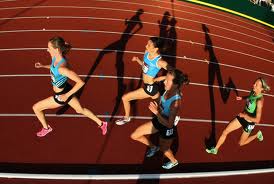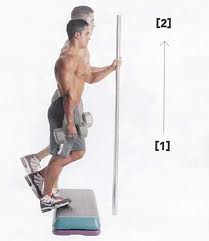Surviving The Transition: The Lower Leg
 I'm helping a few injury prone runners make the slow transition to more of a minimal (or natural) style of running. Previously, I noted several pieces of the puzzle that must be in place for someone to be eligible to adopt this style and I HIGHLY recommend seeing a professional before attempting a form overhaul.
A key ingredient in making a successful transition to better running form is calf strength, flexibility and, maybe most importantly, tissue quality. This is because the sole of the foot and calf must start doing much more work than they are accustomed.
I'm helping a few injury prone runners make the slow transition to more of a minimal (or natural) style of running. Previously, I noted several pieces of the puzzle that must be in place for someone to be eligible to adopt this style and I HIGHLY recommend seeing a professional before attempting a form overhaul.
A key ingredient in making a successful transition to better running form is calf strength, flexibility and, maybe most importantly, tissue quality. This is because the sole of the foot and calf must start doing much more work than they are accustomed.
When someone over-strides their heel crashes into the ground first well out in front of their center of mass. The cushioning in the shoe (and your knee, hip and spine) does the work of absorbing the impact force. Check out this video to see what I mean.
In contrast, when you run “naturally” your foot and calf must work actively to take on the role that your shoe was performing. The arches of your foot will collapse slightly as you land and your calf will stretch more while under load from the body. They then return some of that energy back to you, springing you into your next stride. It's a brilliant system.
A major obstacle to achieving success with this new running form is injury to your plantar fascia (sole of foot), achilles' tendon and calf. Here's how to avoid that!
1. Buy a foam roller and a lacrosse ball. This is critical. The quality of your muscle and fascial tissue is left to chance if you don't consistently address it. When your tissue breaks down due to training, it repairs itself so that it can withstand that stress better next time.
Unfortunately sometimes we create too much muscle damage (by running too far or too fast) and don't give our body ample time to finish the repair process. Or perhaps the repair job was lousy and the muscle fibers didn't heal in the optimal pattern. Investing 1 minute foam rolling your calves (especially mid-calf and lower) and 1 minute massaging the sole of your foot with a lacrosse ball will allow you to continue making progress. Do this before and after your run. Skip this step at your own risk!
at your own risk!
2. After running perform a static stretch for a 30 sec or preferably longer (if you have tight calves). The idea here isn't necessarily to elongate the calf muscle. You're actually looking to inhibit the muscle. After hundreds or thousands of strides your calf muscles will be very 'excited' and contracted. The best thing to do is to GENTLY stretch them in order to promote relaxation. Calm those puppies down and thank me later! (PS: foam rolling also inhibits neuromuscular activity)
3. Preventively, it is wise to develop more strength in your calves. You should be able to complete 30-40 single leg calf raises through full range of motion. Start by seeing if you can reach that number on both legs before progressing to the single leg version.
A Final Point
Transitioning to a more natural form of running is typically good. But too many people don't get the whole concept. You have to make the transition throughout your lifestyle. You need to wear flat, thin soled shoes 95% of the time. You need to stand more and sit less. Your core timing must be good. Remember, it's not just how you run, it's how you show up to the run.
So even if you're not interested in a running form overhaul, I encourage you to adopt the three strategies above for lower leg health and performance. Foam roll, stretch, and strengthen. You won't regret it. Promise!
